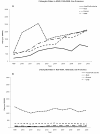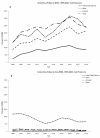Racial/ethnic and sexual behavior disparities in rates of sexually transmitted infections, San Francisco, 1999-2008
- PMID: 20525397
- PMCID: PMC2903517
- DOI: 10.1186/1471-2458-10-315
Racial/ethnic and sexual behavior disparities in rates of sexually transmitted infections, San Francisco, 1999-2008
Abstract
Background: Racial/ethnic minorities and men who have sex with men (MSM) represent populations with disparate sexually transmitted infection (STI) rates. While race-specific STI rates have been widely reported, STI rates among MSM is often challenging given the absence of MSM population estimates. We evaluated the race-specific rates of chlamydia and gonorrhea among MSM and non-MSM in San Francisco between 1999-2008.
Methods: 2000 US Census data for San Francisco was used to estimate the number of African-American, Asian/Pacific Islander, Hispanic, and white males. Data from National HIV Behavioral Surveillance (NHBS) MSM 1, conducted in 2004, was used to estimate the total number of MSM in San Francisco and the size of race/ethnic sub-populations of MSM. Non-MSM estimates were calculated by subtracting the number of estimated MSM from the total number of males residing in San Francisco. Rates of MSM and non-MSM gonorrhea and chlamydia reported between 1999 and 2008 were stratified by race/ethnicity. Ratios of MSM and non-MSM rates of morbidity were calculated by race/ethnicity.
Results: Between 1999-2008, MSM accounted for 72% of gonorrhea cases and 51% of chlamydia cases. Throughout the study period, African-American MSM had the highest chlamydia rate with 606 cases per 100,000 in 1999 increasing to 2067 cases per 100,000 in 2008. Asian/Pacific Islander MSM consistently had the lowest rate among MSM with 1003 cases per 100,000 in 2008. The ratio of MSM/non-MSM for chlamydia was highest among whites 11.6 (95% CI: 8.8-14.4) and Asian/Pacific Islanders 8.6 (95% CI: 6.2-11), and lowest among African-Americans 1.53 (95% CI: 1.2-1.9) and Hispanics 4.43 (95% CI: 2.8-6.0). Gonorrhea rates were similar for African-American, white, and Hispanic MSM between 2137-2441 cases per 100,000 in 2008. Asian/Pacific Islander MSM had the lowest gonorrhea rate with 865 cases per 100,000 in 2008. The ratio of MSM/non-MSM for gonorrhea was highest among whites 11.6 (95% CI: 8.8-14.4) and Asian/Pacific Islanders 8.6 (95% CI: 6.2-11), and lowest among African-Americans 1.53 (95% CI: 1.2-1.9) and Hispanics 4.43 (95% CI: 2.8-6.0).
Conclusions: For all racial/ethnic groups in San Francisco, MSM carried a substantially higher burden of STIs compared to non-MSM except among African-American men. These racial and sexual behavior disparities warrant further public health attention and resources.
Figures




References
-
- Centers for Disease Control and Prevention. Sexually Transmitted Disease Surveillance, 2007. Services US Department of Health and Human Services. Atlanta, GA; 2008.
-
- Centers for Disease Control and Prevention National Center for HIV/AIDS HepatitisViral STD and TB Prevention. 2006 Disease Profile. 2008. pp. 30–35.
-
- STD Control Section. San Francisco Sexually Transmitted Disease Annual Summary, 2006. San Francisco, California: San Francisco Department of Public Health; 2007.
-
- STD Control Section. San Francisco Sexually Transmitted Disease Annual Summary, 2008. San Francsico, CA: San Francisco Department of Public Health; 2008.

